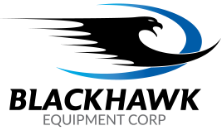Generative AI for Maintenance: Writing Better Work Orders and Troubleshooting Guides
10/08/2025

Over the last couple of years, Generative AI and Large Language Models (LLMs)—the technology behind tools like ChatGPT—have exploded from tech headlines into our daily lives. While we often associate AI in the industrial space with complex predictive analytics, one of its most immediate, powerful, and practical applications for maintenance teams is surprisingly straightforward: revolutionizing communication and knowledge management. For every engineer who has deciphered a vague work order or wished they could clone their most experienced technician, Generative AI offers a tangible solution. As of October 2025, this technology has matured into a robust business tool. At Blackhawk Equipment, we believe that total system reliability depends on both expert service and clear, consistent internal processes. Let's explore how your team can leverage Generative AI today to address some of maintenance's most persistent challenges.
 The Persistent Challenge: Inconsistent Documentation and "Tribal Knowledge"
The Persistent Challenge: Inconsistent Documentation and "Tribal Knowledge"
Every maintenance manager and plant engineer is familiar with the daily struggle of inconsistent documentation. This challenge manifests in several costly ways:
-
Vague Work Orders: Tickets that simply say "Pump is noisy," "Compressor #2 is down," or "Air leak" provide no context, forcing the technician to start their diagnostic process from scratch every single time.
-
Lack of Standardized Procedures (SOPs): The "best" way to perform a specific repair often exists only in the head of a senior technician. This "tribal knowledge" is highly effective but impossible to scale and dangerously vulnerable to loss when that technician is on vacation, sick, or retires.
-
Inconsistent Repairs: Without clear, step-by-step guides, two different technicians might tackle the same problem in two different ways, leading to inconsistent repair quality and unpredictable results.
-
The Widening Skills Gap: As experienced technicians retire, new team members are left without access to decades of hands-on wisdom, making the training process longer and more challenging.
Enter Generative AI: Your New Expert Documentation Assistant
Think of a Generative AI model as a highly advanced assistant. It has been trained on a massive library of text, including technical manuals, reports, and human language. It excels at understanding a request (a "prompt"), processing information, and generating well-structured, coherent text in a specified format. It is not a replacement for a skilled technician's hands-on expertise and critical thinking. Instead, it is a powerful tool for that technician, designed to amplify their knowledge and drastically reduce the time spent on documentation.
Practical Application 1: Writing Clear, Comprehensive, and Actionable Work Orders
This is the most immediate way to see a return on using AI. Let's look at a before-and-after example.
The Old Way: A Vague Request
- A work order is submitted with a one-line description:
Fix noisy pump P-101.The technician arrives with minimal information, wasting valuable time just to understand the basic symptoms.
The New Way: A Detailed Scope in Seconds
-
A supervisor or even the operator who noticed the issue provides a slightly more detailed prompt to an AI tool:
-
Prompt Example: `"I have a noisy pump, a Grundfos CR 10-5, with motor number X. The noise is a high-pitched whine that gets worse when the system is under high load. Based on this, create a detailed diagnostic work order for a senior technician. The work order must include these five sections: 1. Mandatory Safety Pre-Checks (LOTO for the motor and any associated valves, required PPE). 2. A list of likely root causes for a high-pitched whine. 3. A numbered list of initial diagnostic steps to perform. 4. A list of recommended tools and test equipment. 5. A section for the technician to record their findings and parts used."*
-
In seconds, the AI can generate a structured, professional work order that includes potential causes like bearing wear, motor issues, or cavitation, and suggests logical diagnostic steps. This ensures a consistent, safe, and efficient approach every time, regardless of which technician is assigned the job.
Practical Application 2: Creating Standardized Troubleshooting Guides
This is where Generative AI becomes a powerful tool for capturing and scaling that invaluable "tribal knowledge."
From Conversation to SOP in Minutes:
-
Imagine a maintenance manager has a 15-minute conversation with their top compressor technician, asking them, "When a compressor shuts down on high temperature, what are the first ten things you check, in order?" The manager records the audio or types up rough notes.
-
They can then feed this raw transcript to an AI with a prompt like: `"Based on the following notes from an expert technician, create a formal, step-by-step troubleshooting guide titled 'SOP-001: Diagnosing High-Temperature Shutdowns in Rotary Screw Compressors.' Use clear headings for each step, use bullet points for sub-tasks, and add a 'Safety First' section at the beginning."*
-
The AI instantly transforms that informal conversation into a permanent, well-formatted, and easy-to-follow Standard Operating Procedure. This document can now be used to train junior technicians and ensure everyone follows the same best-practice methodology.

Distilling Knowledge from OEM Manuals:
-
We've all faced it: a 300-page OEM manual and a single, cryptic fault code on a machine's controller. Modern AI tools can process PDF documents. An engineer could upload a Sullair manual and use a prompt like: `"From the attached manual, find all information related to Fault Code F-12. Summarize the likely causes and create a simple troubleshooting checklist for a technician to follow."* This can save hours of searching and get to the solution faster.
The Tangible Benefits of Better Documentation
-
Improved Consistency and Quality: Repairs are performed to a consistent standard.
-
Faster and More Accurate Diagnostics: Technicians are equipped with a logical, step-by-step process.
-
Enhanced Knowledge Transfer: The skills gap is bridged by documenting the wisdom of senior staff.
-
Better Data for Your CMMS: Detailed and standardized work orders provide clean data for analyzing maintenance metrics, tracking asset health, and identifying recurring problems.
-
A Reinforced Safety Culture: By programmatically including safety pre-checks in every generated work order, you ensure safety is always the first step.
Implementing AI Responsibly: The "Human in the Loop" is Non-Negotiable
-
AI is a Drafting Tool, Not the Final Authority: This is the most important rule. Generative AI can occasionally be wrong or "hallucinate" information. A qualified human—an experienced engineer or senior technician—must always review, edit, and approve any AI-generated content before it is used for actual maintenance work. The AI creates the first draft; the human provides the final validation.
-
Data Privacy and Security: Be cautious about inputting sensitive operational data or proprietary company information into public AI models. For regular use, companies should invest in enterprise-grade, secure AI platforms that protect their data.
How This Aligns with the Blackhawk Philosophy
At Blackhawk Equipment, our philosophy is centered on a holistic approach to system reliability. While our expert technicians provide best-in-class hands-on service, we know that the day-to-day maintenance practices of our customers are a massive factor in the long-term health of their equipment. We see Generative AI as a phenomenal tool to empower our customers' own teams. By helping them create better documentation and standardized procedures for the equipment we supply and service, we contribute to a safer, more efficient, and more reliable plant overall.
Conclusion: Your New AI Assistant is Ready to Work
Generative AI is no longer a futuristic concept; it is a practical tool available to every modern maintenance department today. Its ability to instantly structure information, standardize communication, and capture expertise offers a powerful solution to some of the industry's most long-standing challenges. By embracing AI as a documentation assistant—always under the careful supervision of a human expert—engineering and maintenance teams can free up valuable time, improve the quality of their work, and build a lasting library of operational knowledge. This allows your most skilled people to spend less time on paperwork and more time doing what they do best: solving complex problems.
While Blackhawk's expertise lies in mechanical systems, we encourage all our clients to explore these powerful digital tools. When you need the expert knowledge to craft the "perfect prompt" for your critical utility systems, you know who to call.
